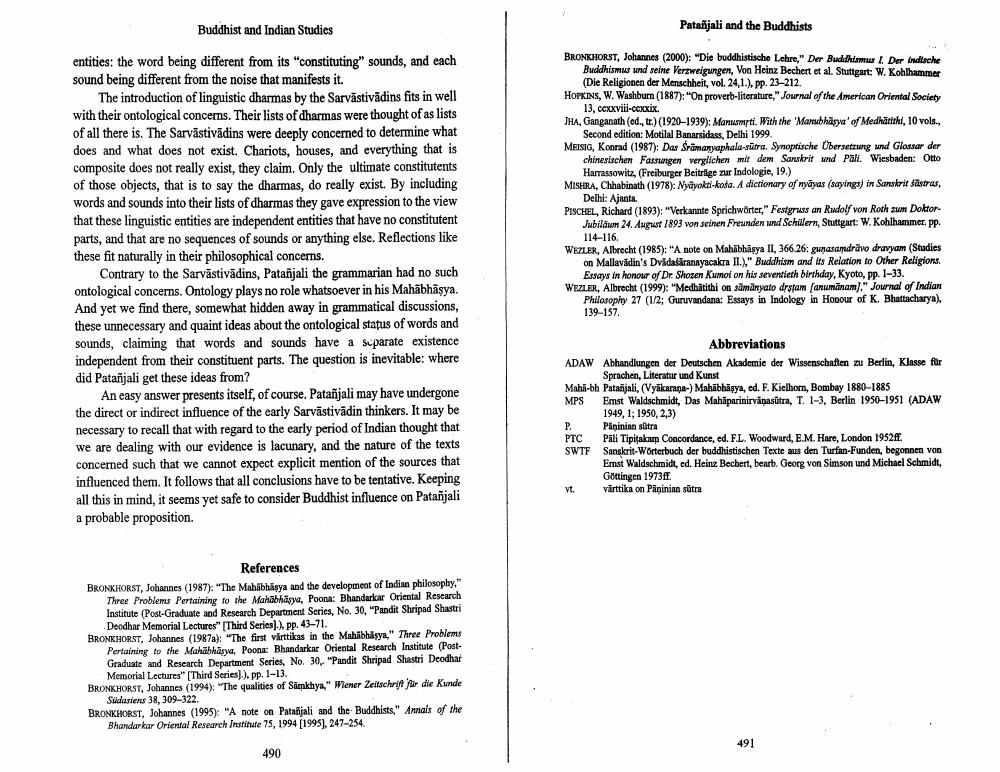Book Title: Patanjali And Buddhists Author(s): Johannes Bronkhorst Publisher: Johannes Bronkhorst View full book textPage 4
________________ Buddhist and Indian Studies Patanjali and the Buddhists entities: the word being different from its "constituting" sounds, and each sound being different from the noise that manifests it. The introduction of linguistic dharmas by the Sarvastivadins fits in well with their ontological concerns. Their lists of dharmas were thought of as lists of all there is. The Sarvastivadins were deeply concerned to determine what does and what does not exist. Chariots, houses, and everything that is composite does not really exist, they claim. Only the ultimate constitutents of those objects, that is to say the dharmas, do really exist. By including words and sounds into their lists of dharmas they gave expression to the view that these linguistic entities are independent entities that have no constitutent parts, and that are no sequences of sounds or anything else. Reflections like these fit naturally in their philosophical concerns. Contrary to the Sarvastivadins, Patanjali the grammarian had no such ontological concerns. Ontology plays no role whatsoever in his Mahabhasya. And yet we find there, somewhat hidden away in grammatical discussions, these unnecessary and quaint ideas about the ontological status of words and sounds, claiming that words and sounds have a separate existence independent from their constituent parts. The question is inevitable: where did Patanjali get these ideas from? An easy answer presents itself, of course. Patanjali may have undergone the direct or indirect influence of the early Sarvastivadin thinkers. It may be necessary to recall that with regard to the early period of Indian thought that we are dealing with our evidence is lacunary, and the nature of the texts concerned such that we cannot expect explicit mention of the sources that influenced them. It follows that all conclusions have to be tentative. Keeping all this in mind, it seems yet safe to consider Buddhist influence on Patanjali a probable proposition. BRONKHORST, Johannes (2000): "Die buddhistische Lehre," Der Buddhismus I. Der indische Buddhismus und seine Verzweigungen, Von Heinz Bechert et al. Stuttgart: W. Kohlhammer (Die Religionen der Menschheit, vol. 24,1.), pp. 23-212. HOPKINS, W. Washburn (1887): "On proverb-literature," Journal of the American Oriental Society 13, ccxxviii-ccxxix. JHA, Ganganath (ed., tr.) (1920-1939): Manusmrti. With the Manubhasya' of Medhatithi, 10 vols., Second edition: Motilal Banarsidass, Delhi 1999. MEISIG, Konrad (1987): Das Sramanyaphala-sutra. Synoptische Ubersetzung und Glossar der chinesischen Fassungen verglichen mit dem Sanskrit und Pali. Wiesbaden: Otto Harrassowitz, (Freiburger Beitrage zur Indologie, 19.) MISHRA, Chhabinath (1978): Nyayokti-kosa. A dictionary of nyayas (sayings) in Sanskrit sastras, Delhi: Ajanta. PISCHEL, Richard (1893): "Verkannte Sprichworter," Festgruss an Rudolf von Roth zum Dolor Jubilaum 24. August 1893 von seinen Freunden und Schulern, Stuttgart: W. Kohlhammer. pp. 114-116. echt (1985): "A note on Mahabhasya II, 366.26: gunasamdravo dravyam (Studies on Mallavadin's Dvadasaranayacakra II.)," Buddhism and its Relation to Other Religions. Essays in honour of Dr. Shozen Kumoi on his seventieth birthday, Kyoto, pp. 1-33. WEZLER, Albrecht (1999): "Medhatithi on samanyato drstam [anumanam)," Journal of Indian Philosophy 27 (1/2; Guruvandana: Essays in Indology in Honour of K. Bhattacharya), 139-157. Abbreviations ADAW Abhandlungen der Deutschen Akademie der Wissenschaften zu Berlin, Klasse fur Sprachen, Literatur und Kunst Maha-bh Patanjali, (Vyakarana-) Mahabhasya, ed. F. Kielhorn, Bombay 1880-1885 MPS Ernst Waldschmidt, Das Mahaparinirvapasutra, T. 1-3, Berlin 1950-1951 (ADAW 1949, 1; 1950, 2,3) P. Paninian sutra PTC Pali Tipitakam Concordance, ed. F.L. Woodward, E.M. Hare, London 1952ff. SWTF Sanskrit-Worterbuch der buddhistischen Texte aus den Turfan-Funden, begonnen von Ernst Waldschmidt, ed. Heinz Bechert, bearb. Georg von Simson und Michael Schmidt, Gottingen 1973ff. Vt. varttika on Paninian sutra References BRONKHORST Iohannes (1987). "The Mahabhasva and the development of Indian philosophy," Three Problems Pertaining to the Mahabhasya, Poona: Bhandarkar Oriental Research Institute (Post-Graduate and Research Department Series, No. 30, "Pandit Shripad Shastri Deodhar Memorial Lectures" [Third Series].), pp. 43-71. BRONKHORST, Johannes (1987a): "The first varttikas in the Mahabhasya," Three Problems Pertaining to the Mahabhasya, Poona: Bhandarkar Oriental Research Institute (PostGraduate and Research Department Series, No. 30, "Pandit Shripad Shastri Deodhar Memorial Lectures" [Third Series].), pp. 1-13. BRONKHORST, Johannes (1994): "The qualities of Samkhya," Wiener Zeitschrift fur die Kunde Sudasiens 38, 309-322. BRONKHORST, Johannes (1995): "A note on Patanjali and the Buddhists," Annals of the Bhandarkar Oriental Research Institute 75, 1994 (1995), 247-254. 491 490Page Navigation
1 2 3 4
